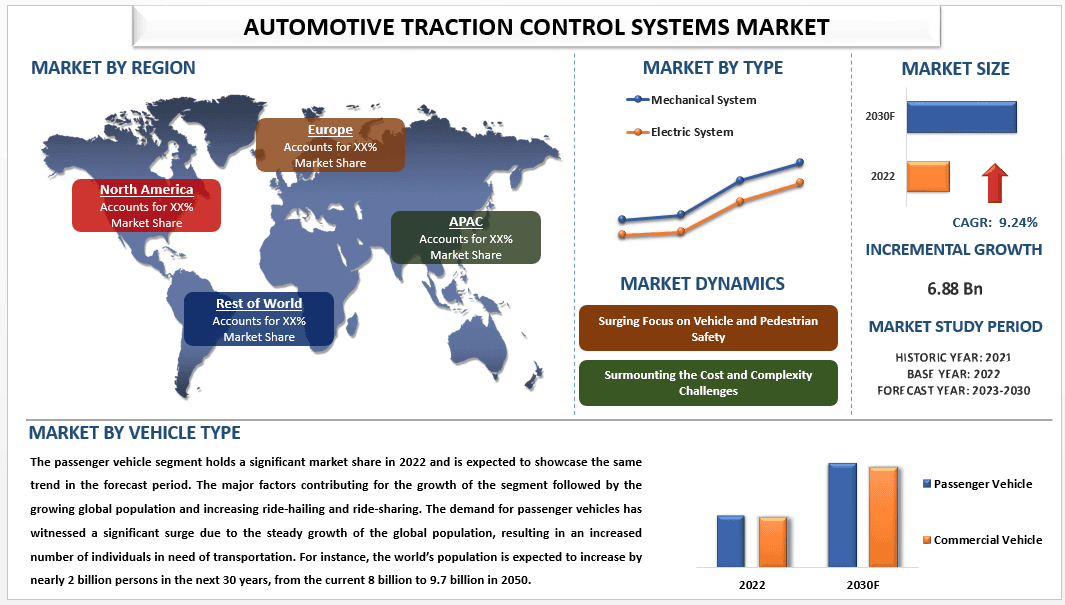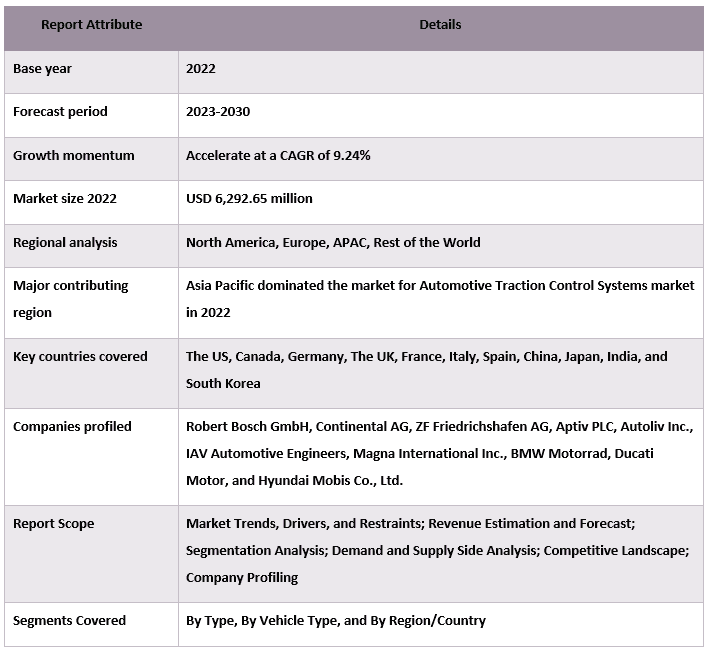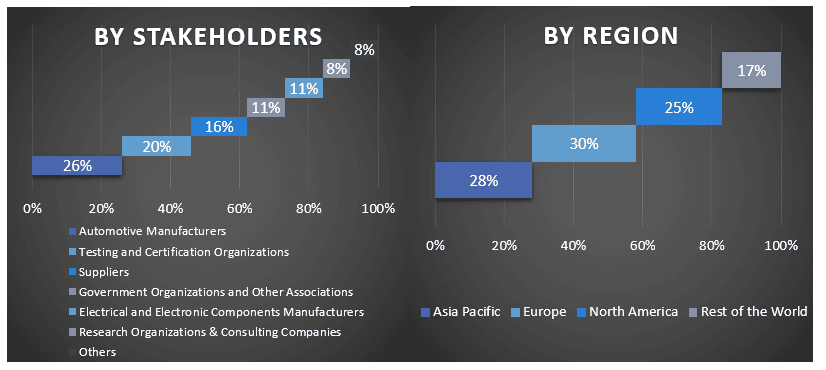- Accueil
- À propos de nous
- Industrie
- Services
- Lecture
- Contactez-nous
Marché des systèmes de contrôle de traction automobile : Analyse actuelle et prévisions (2023-2030)
Accent sur le type (système mécanique et système électrique) ; type de véhicule (véhicule de tourisme et véhicule utilitaire) ; et région/pays

Le marché des systèmes de contrôle de traction automobile devrait croître à un TCAC élevé d'environ 9,24 % au cours de la période de prévision en raison des mandats gouvernementaux stricts et des protocoles NCAP. Les gouvernements du monde entier ont mis en œuvre des lois et des procédures de test plus strictes pour garantir l'utilisation du contrôle de traction et de l'ESC. La National Highway Traffic Safety Administration (NHTSA) a fixé l'exigence que tous les véhicules aux États-Unis pesant moins de 10 000 lb soient équipés d'un ESC d'ici 2022. De même, les réglementations de l'UE rendent obligatoire le déploiement de l'ESC dans tous les nouveaux modèles de voitures. En outre, Bharat NCAP, dans le cadre de son initiative « Voitures plus sûres pour l'Inde », attribue des cotes de sécurité plus élevées aux voitures équipées d'un système de contrôle de traction.
Ces réglementations ont incité les principaux équipementiers tels que VW, Toyota et Hyundai à adopter universellement les systèmes de traction. Par exemple, Maruti Suzuki a ajouté l'ESC à ses modèles pour se conformer aux réglementations indiennes plus strictes. La principale motivation de la mise en œuvre du contrôle de traction est de garantir la conformité réglementaire. La Chine imposant également l'utilisation de l'ESC à partir de 2022 en vertu de son protocole C-NCAP et compte tenu de sa position de plus grand marché automobile au monde, les pressions réglementaires stimulent considérablement l'adoption de systèmes de traction dans les principales économies. De plus, ces mandats ont des retombées positives, encourageant les constructeurs automobiles à intégrer des commandes de stabilité du véhicule plus avancées, telles que la vectorisation du couple. En conséquence, les systèmes de traction deviennent des éléments essentiels pour répondre aux réglementations de sécurité et aux protocoles de test.
Certains des principaux acteurs opérant sur le marché comprennent Robert Bosch GmbH, Continental AG, ZF Friedrichshafen AG, Aptiv PLC, Autoliv Inc., IAV Automotive Engineers, Magna International Inc., BMW Motorrad, Ducati Motor et Hyundai Mobis Co., Ltd. Plusieurs fusions et acquisitions ainsi que des partenariats ont été entrepris par ces acteurs pour offrir aux clients des produits/technologies innovants et de haute technologie.
Aperçus présentés dans le rapport
« Parmi les types, le segment des systèmes électriques a dominé le marché en 2022. »
Selon le type, le marché est divisé en système mécanique et système électrique. Le segment des systèmes électriques a dominé le marché en 2022 et devrait afficher la même tendance au cours de la période de prévision. Les principaux facteurs contribuant à la croissance sont l'industrie du transport et de la logistique en pleine croissance, qui a reconnu les avantages des véhicules électriques pour réduire les coûts de carburant et les émissions. Les entreprises de livraison, les services de taxi et les systèmes de transport public ont commencé à intégrer des véhicules électriques dans leurs flottes, ce qui stimule la demande de systèmes de contrôle de traction électrique. Divers gouvernements du monde entier ont mis en œuvre des normes d'émissions strictes et des incitations pour stimuler l'adoption des véhicules électriques. Le système mécanique de contrôle automatique de la traction est devenu crucial en raison de sa fiabilité et de sa polyvalence. En mettant de plus en plus l'accent sur la sécurité routière, les gouvernements et les organisations du monde entier promeuvent activement l'adoption de technologies qui minimisent les accidents et améliorent les conditions de conduite. Le système mécanique, avec sa capacité à gérer le patinage des roues et à optimiser la traction en temps réel, a acquis une immense popularité auprès des constructeurs automobiles et des consommateurs.
« Parmi les types de véhicules, le segment des moins de 6 pouces a généré les revenus les plus élevés en 2022. »
- Selon le type de véhicule, le marché est divisé en véhicules de tourisme et véhicules utilitaires. Le segment des véhicules de tourisme détient une part de marché importante en 2022 et devrait afficher la même tendance au cours de la période de prévision. Les principaux facteurs contribuant à la croissance du segment sont la croissance de la population mondiale et l'augmentation des services de covoiturage et de transport à la demande. La demande de véhicules de tourisme a connu une augmentation importante en raison de la croissance constante de la population mondiale, ce qui a entraîné un nombre accru de personnes ayant besoin de transport. Par exemple, la population mondiale devrait augmenter de près de 2 milliards de personnes au cours des 30 prochaines années, passant de 8 milliards actuellement à 9,7 milliards en 2050. De plus, l'ATCS joue un rôle crucial dans l'amélioration des performances du véhicule et la maximisation du rendement énergétique. En adaptant automatiquement la distribution de puissance aux roues, ces systèmes avancés éliminent efficacement le gaspillage d'énergie causé par le patinage des roues. Par conséquent, les véhicules de tourisme équipés d'ATCS connaissent une amélioration notable de l'économie de carburant, ce qui plaît aux consommateurs soucieux de l'environnement et offre des avantages financiers substantiels à long terme. De plus, la tendance mondiale croissante vers la mobilité électrique a considérablement stimulé le besoin de systèmes de contrôle automatique de la traction. Par exemple, en 2023, selon le rapport publié par l'Agence internationale de l'énergie, les voitures électriques de tourisme gagnent en popularité et on estime que 18 % des nouvelles voitures vendues en 2023 seront électriques. De plus, les marchés des voitures électriques connaissent une croissance exponentielle, les ventes ayant dépassé les 10 millions en 2022, et la part des voitures électriques dans les ventes totales a plus que triplé en trois ans, passant d'environ 4 % en 2020 à 14 % en 2022.
Couverture du rapport sur le marché des systèmes de contrôle de traction automobile

« La région Asie-Pacifique a dominé le marché des systèmes de contrôle de traction automobile en 2022. »
Le marché des systèmes de contrôle de traction automobile en Asie-Pacifique a dominé le marché et devrait se comporter de la même manière au cours de la période de prévision. La croissance est principalement tirée par l'augmentation de la population et de la demande de transport, les avancées technologiques et l'urbanisation croissante. La région Asie-Pacifique abrite 60 % de la population mondiale, dominée par la Chine et l'Inde. La région Asie-Pacifique a connu la plus forte croissance du marché automobile au cours des dernières années. La croissance est principalement tirée par l'augmentation de la population, la demande de transport, les avancées technologiques et la croissance des infrastructures et de l'urbanisation. La région Asie-Pacifique abrite 60 % de la population mondiale, dominée par l'Inde et la Chine. Les principaux constructeurs automobiles se trouvent dans la même région, tels que Honda, Suzuki, Hyubdai, Mahindra, KIA et Changan. Ces sociétés ont accéléré la demande de ventes et accru le marché des systèmes de contrôle de traction dans la région. Par exemple, selon le rapport publié par l'Organisation Internationale des Constructeurs d'Automobiles, le nombre total de véhicules de tourisme vendus est passé de 28,29 millions d'unités en 2021 dans les cinq principaux pays à 31,08 millions d'unités en 2022.
Raisons d'acheter ce rapport :
- L'étude comprend une analyse de la taille et des prévisions du marché validée par des experts clés authentifiés du secteur.
- Le rapport présente un aperçu rapide des performances globales du secteur en un coup d'œil.
- Le rapport couvre une analyse approfondie des principaux acteurs du secteur, en mettant l'accent sur les principales données financières de l'entreprise, les portefeuilles de produits, les stratégies d'expansion et les développements récents.
- Examen détaillé des moteurs, des contraintes, des tendances clés et des opportunités qui prévalent dans l'industrie.
- L'étude couvre de manière exhaustive le marché à travers différents segments.
- Analyse approfondie au niveau régional de l'industrie.
Options de personnalisation :
Le marché mondial des systèmes de contrôle de traction automobile peut être davantage personnalisé selon les besoins ou tout autre segment de marché. En outre, UMI comprend que vous pouvez avoir vos propres besoins commerciaux, n'hésitez donc pas à nous contacter pour obtenir un rapport qui répond parfaitement à vos besoins.
Table des matières
Méthodologie de recherche pour l'analyse du marché des systèmes de contrôle de traction automobile (2023-2030)
L'analyse du marché historique, l'estimation du marché actuel et la prévision du marché futur du marché mondial des systèmes de contrôle de traction automobile ont été les trois étapes majeures entreprises pour créer et analyser l'adoption des systèmes de contrôle de traction automobile dans les principales régions du monde. Des recherches secondaires exhaustives ont été menées pour collecter les chiffres historiques du marché et estimer la taille actuelle du marché. Deuxièmement, pour valider ces informations, de nombreuses conclusions et hypothèses ont été prises en considération. De plus, des entretiens primaires exhaustifs ont également été menés avec des experts de l'industrie tout au long de la chaîne de valeur du marché mondial des systèmes de contrôle de traction automobile. Après l'hypothèse et la validation des chiffres du marché par le biais d'entretiens primaires, nous avons utilisé une approche descendante/ascendante pour prévoir la taille complète du marché. Par la suite, des méthodes de ventilation du marché et de triangulation des données ont été adoptées pour estimer et analyser la taille du marché des segments et sous-segments de l'industrie concernée. Une méthodologie détaillée est expliquée ci-dessous :
Analyse de la taille historique du marché
Étape 1 : Étude approfondie des sources secondaires :
Une étude secondaire détaillée a été menée pour obtenir la taille historique du marché du marché des systèmes de contrôle de traction automobile grâce à des sources internes à l'entreprise telles querapports annuels et états financiers, présentations de performance, communiqués de presse, etc.,et des sources externes, y comprisjournaux, actualités et articles, publications gouvernementales, publications de concurrents, rapports sectoriels, bases de données tierces et autres publications crédibles.
Étape 2 : Segmentation du marché :
Après avoir obtenu la taille historique du marché du marché des systèmes de contrôle de traction automobile, nous avons mené une analyse secondaire détaillée pour recueillir des informations historiques sur le marché et des parts pour différents segments et sous-segments pour les principales régions. Les principaux segments sont inclus dans le rapport, tels que le type et le type de véhicule. D'autres analyses au niveau des pays ont été menées pour évaluer l'adoption globale des modèles de test dans cette région.
Étape 3 : Analyse des facteurs :
Après avoir acquis la taille historique du marché de différents segments et sous-segments, nous avons mené uneanalyse factorielledétaillée pour estimer la taille actuelle du marché du marché des systèmes de contrôle de traction automobile. De plus, nous avons mené une analyse factorielle en utilisant des variables dépendantes et indépendantes telles que le type et le type de véhicule du marché des systèmes de contrôle de traction automobile. Une analyse approfondie a été menée sur les scénarios de l'offre et de la demande en tenant compte des principaux partenariats, fusions et acquisitions, de l'expansion commerciale et des lancements de produits dans le secteur du marché des systèmes de contrôle de traction automobile à travers le monde.
Estimation et prévision de la taille actuelle du marché
Dimensionnement actuel du marché :Sur la base d'informations exploitables tirées des 3 étapes ci-dessus, nous sommes parvenus à la taille actuelle du marché, aux principaux acteurs du marché mondial des systèmes de contrôle de traction automobile et aux parts de marché des segments. Toutes les parts en pourcentage requises, les ventilations du marché ont été déterminées en utilisant l'approche secondaire susmentionnée et ont été vérifiées par le biais d'entretiens primaires.
Estimation et prévision :Pour l'estimation et les prévisions du marché, des pondérations ont été attribuées aux différents facteurs, notamment les moteurs et les tendances, les contraintes et les opportunités disponibles pour les parties prenantes. Après avoir analysé ces facteurs, des techniques de prévision pertinentes, c'est-à-dire l'approche descendante/ascendante, ont été appliquées pour parvenir aux prévisions du marché pour 2030 pour différents segments et sous-segments sur les principaux marchés du monde. La méthodologie de recherche adoptée pour estimer la taille du marché comprend :
- La taille du marché de l’industrie, en termes de chiffre d'affaires (USD) et le taux d'adoption du marché des systèmes de contrôle de traction automobile sur les principaux marchés nationaux.
- Toutes les parts en pourcentage, les répartitions et les ventilations des segments et sous-segments de marché.
- Acteurs clés du marché mondial des systèmes de contrôle de traction automobile en termes de produits proposés. De plus, les stratégies de croissance adoptées par ces acteurs pour concurrencer sur le marché en forte croissance.
Validation de la taille et de la part de marché
Recherche primaire :Des entretiens approfondis ont été menés avec les principaux leaders d'opinion (KOL), y compris les cadres supérieurs (CXO/VP, responsables des ventes, responsables du marketing, responsables opérationnels, responsables régionaux, responsables nationaux, etc.) dans les principales régions. Les résultats de la recherche primaire ont ensuite été résumés et une analyse statistique a été effectuée pour prouver l'hypothèse énoncée. Les contributions de la recherche primaire ont été consolidées avec les résultats secondaires, transformant ainsi l'information en informations exploitables.
Répartition des participants principaux dans les différentes régions

Ingénierie de marché
La technique de triangulation des données a été employée pour compléter l'estimation globale du marché et pour obtenir des chiffres statistiques précis pour chaque segment et sous-segment du marché mondial des systèmes de contrôle de traction automobile. Les données ont été divisées en plusieurs segments et sous-segments après l'étude de divers paramètres et tendances dans les domaines du type et du type de véhicule sur le marché mondial des systèmes de contrôle de traction automobile.
L'objectif principal de l'étude de marché des systèmes de contrôle de traction automobile
Les tendances actuelles et futures du marché mondial des systèmes de contrôle de traction automobile ont été mises en évidence dans l'étude. Les investisseurs peuvent obtenir des informations stratégiques pour baser leur discrétion en matière d'investissements sur l'analyse qualitative et quantitative effectuée dans l'étude. Les tendances actuelles et futures du marché ont déterminé l'attractivité globale du marché au niveau régional, offrant une plateforme aux participants industriels pour exploiter le marché inexploité afin de bénéficier d'un avantage du premier arrivé. D'autres objectifs quantitatifs des études comprennent :
- Analyser la taille actuelle et prévue du marché des systèmes de contrôle de traction automobile en termes de valeur (USD). Analyser également la taille actuelle et prévue du marché des différents segments et sous-segments.
- Les segments de l'étude comprennent les domaines du type et du type de véhicule.
- Définir et analyser le cadre réglementaire des systèmes de contrôle de traction automobile
- Analyser la chaîne de valeur impliquée avec la présence de divers intermédiaires, ainsi que l'analyse des comportements des clients et des concurrents de l'industrie.
- Analyser la taille actuelle et prévue du marché des systèmes de contrôle de traction automobile pour la région principale.
- Les principaux pays des régions étudiées dans le rapport comprennent l'Asie-Pacifique, l'Europe, l'Amérique du Nord et le reste du monde
- Profil de l'entreprise du marché des systèmes de contrôle de traction automobile et les stratégies de croissance adoptées par les acteurs du marché pour se maintenir sur le marché en forte croissance.
- Analyse approfondie au niveau régional de l'industrie
Questions Fréquemment Posées FAQ
Q1 : Quelle est la taille actuelle du marché et le potentiel de croissance du marché mondial des systèmes de contrôle de traction automobile ?
Q2 : Quels sont les facteurs moteurs de la croissance du marché mondial des systèmes de contrôle de traction automobile ?
Q3 : Quel segment détient la plus grande part du marché mondial des systèmes de contrôle de traction automobile par type de véhicule ?
Q4 : Quelles sont les technologies et les tendances émergentes sur le marché mondial des systèmes de contrôle de traction automobile ?
Q5 : Quelle région dominera le marché mondial des systèmes de contrôle de traction automobile ?
Q6 : Qui sont les principaux acteurs opérant sur le marché mondial des systèmes de contrôle de traction automobile ?
Connexes Rapports
Les clients qui ont acheté cet article ont également acheté










